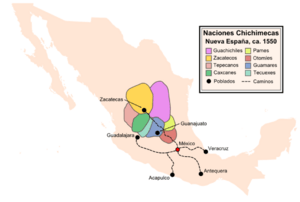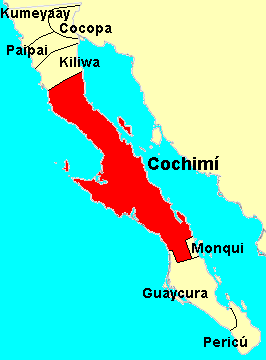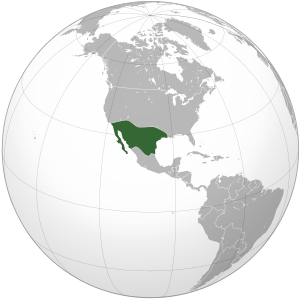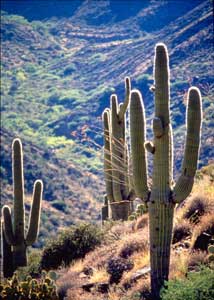Aridoamerica facts for kids
Aridoamerica is a dry, desert-like area that stretches across parts of Northern Mexico and the Southwestern United States. It's known for a special bean called Phaseolus acutifolius (tepary bean), which can grow well even with little water. This region is very different from the green, lush Mesoamerica to its south and east, and the higher, milder Oasisamerica to its north. Aridoamerica actually touches both of these other regions.
Because of the tough, dry conditions, the people who lived here long ago, before Christopher Columbus arrived, developed unique ways of life and farming. The area gets only about 120 to 160 millimeters (5 to 6 inches) of rain each year. This small amount of rain feeds seasonal streams and waterholes.
The name "Aridoamerica" was first used by anthropologist Paul Kirchhoff in 1954. Later, Gary Paul Nabhan helped define it as a specific cultural area in 1985. Another expert, Guillermo Bonfil Batalla, explained that while it's helpful to see Aridoamerica and Mesoamerica as different, the border between them wasn't a strict wall. Instead, it was a changing line, and people from Aridoamerica often interacted with the civilizations to the south.
Contents
How Did People Live in Aridoamerica?

The Chichimeca were groups of people who lived in the grasslands of Aridoamerica. They were mostly hunter-gatherers. This means they found their food by hunting animals and gathering wild plants. They collected things like maguey plants, yucca flowers, mesquite beans, chia seeds, and different types of cacti, including the pads and fruits of the nopal cactus. The Agave americana plant was especially important for them.
Even though it was dry, Aridoamerica is home to many different kinds of wild and farmed tepary beans. It might even be where these beans were first grown by people. Maize (corn) farming started in Aridoamerica around 2100 BCE. Experts aren't sure if corn was brought by people moving from Mesoamerica or if the idea of growing it spread from other groups.
In Baja California, people found food by fishing and hunting. They also gathered acorns, nopal, pine nuts, and other native plants. Some people in Aridoamerica would cut willow tree trunks down to stumps. This made new, thin shoots grow, which they would weave tightly into waterproof baskets for cooking. They would heat rocks in a fire and then drop them into the baskets to cook their food.
Deserts of Aridoamerica
Aridoamerica is home to several famous deserts, each with its own unique features.
The Chihuahuan Desert
The Chihuahuan Desert has elevations from about 600 to 1,700 meters (1,970 to 5,500 feet). It includes smaller mountain ranges like the San Andres and Franklin Mountains. This desert is a "rain shadow" desert. This means it's located between two mountain ranges (the Sierra Madre Occidental and Sierra Madre Oriental) that block rain from reaching the area. The Chihuahuan Desert is considered one of the most diverse deserts in the world, with more types of cacti than any other desert. Common plants here are agave, yucca, and creosote bushes, along with many cacti.
The Sonoran Desert
When people think of the desert in the southwestern United States, they often imagine the Sonoran Desert. This desert gets about 10 to 30 centimeters (4–12 inches) of rain each year. Its most famous plant is the giant saguaro cactus, which only grows in this desert. The Sonoran Desert has the most diverse plant life of any desert in the world. Besides the saguaro, you can find many other cacti like the organ-pipe, prickly pear, and barrel cacti.
The Mojave Desert
The northwestern part of Aridoamerica is covered by the Mojave Desert. It's similar in shape to the Great Basin Desert to its north. The Mojave gets less than 15 centimeters (6 inches) of rain annually. Its elevation ranges from about 900 to 1,800 meters (3,000 to 6,000 feet) above sea level. The most common plant here is the tall Joshua tree, which can grow up to 12 meters (40 feet) tall and live for almost 1,000 years. Other plants found only in the Mojave include the Parry saltbush and Mojave sage.
Amazing Wildlife
Aridoamerica is full of incredible animals, especially birds!
Birds of the Desert
Hundreds of bird species live in Aridoamerica. For example, in the Chiricahua Mountains in Arizona, you can find over 400 different kinds of birds. Some common birds include Canada and snow geese, sandhill cranes, and the famous roadrunner.
Birds of prey, which hunt other animals, are also common. These include the red-tailed hawk, Cooper's hawk, osprey, golden eagle, bald eagle, and many types of owls like the barn owl and great horned owl.
Other colorful and interesting birds you might see are the northern cardinal, blue grosbeak, house finch, and many types of hummingbirds like the broad-billed hummingbird and Anna's hummingbird. You can also find the Gambel's quail, common raven, and the cactus wren.
Mammals of Aridoamerica
Many mammals call Aridoamerica home. You might spot a bobcat, coyote, or collared peccary (a pig-like animal). Larger mammals include the black bear, mule deer, and desert bighorn sheep.
Other interesting mammals are the black-tailed jackrabbit, desert cottontail, ringtail, gray fox, and kit fox. You might even see a mountain lion, raccoon, or the unique white-nosed coati. Rare animals like the jaguar and Mexican wolf also live in parts of this region. There are also many different kinds of bats, kangaroo rats, and woodrats.
Reptiles and Amphibians
Aridoamerica is home to many reptiles, including snakes, lizards, and turtles.
Snakes
There are many types of snakes, some of which are venomous. Examples include the rosy boa, several kinds of glossy snakes, and kingsnakes like the desert kingsnake. Venomous snakes include the Arizona coral snake, western diamondback rattlesnake, and several other types of rattlesnakes, such as the Sonoran sidewinder and the Grand Canyon rattlesnake.
Lizards and Turtles
Lizards are very common. The most famous is the Gila monster, a large, venomous lizard found only in the American Southwest and Sonora, Mexico. Other lizards include Sonoran collared lizards, different types of geckos, the desert iguana, and the chuckwalla. You can also find various horned lizards and spiny lizards.
Turtles are less common but still present. These include the western painted turtle, desert box turtle, and the desert tortoise.
Toads, Frogs, and Salamanders
Amphibians like toads and frogs live near water sources. Toads include the Great Plains toad and the Colorado River toad (also known as the Sonoran Desert toad). Frogs include the canyon tree frog and the Chiricahua leopard frog. There are also a few types of salamanders, such as the Arizona tiger salamander.
Where is Aridoamerica?
Aridoamerica covers parts of both Mexico and the United States.
Mexican States in Aridoamerica
- Aguascalientes
- Baja California
- Baja California Sur
- Coahuila
- Chihuahua
- Durango
- Nayarit
- Nuevo León
- San Luis Potosí
- Sinaloa
- Sonora
- Tamaulipas
- Zacatecas
The northern parts of these states are also in Aridoamerica:
U.S. States in Aridoamerica
Cultures of Aridoamerica

Many different indigenous groups lived in Aridoamerica. Some of these cultures include:
- Acaxee
- Caxcane
- Cochimí (from Baja California)
- Cocopá (from Baja California)
- Guachichil
- Guachimontone
- Guamare
- Guaycura (from Baja California)
- Huarijio
- Huichol
- Kiliwa (from Baja California)
- Kumiai (from Baja California)
- Mayo
- Mogollon culture (also found in Oasisamerica)
- Monqui (from Baja California)
- Opata
- Otomi
- Pai Pai (from Baja California)
- Pame
- Pericúe (from Baja California)
- Pima Bajo
- Seri
- Tarahumara
- Tecuexe
- Tepecano
- Tepehuán
- Teuchitlan tradition
- Western Mexico shaft tomb tradition
- Yaqui
- Zacateco
See also
 In Spanish: Aridoamérica para niños
In Spanish: Aridoamérica para niños





